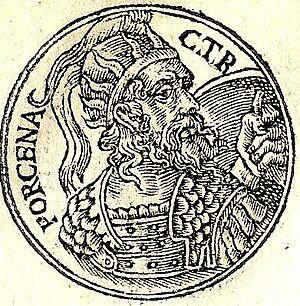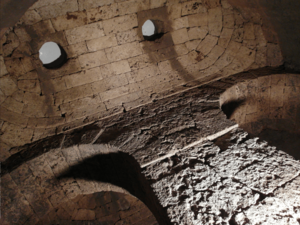Lars Porsena facts for kids
Lars Porsena was a powerful Etruscan king. He is famous for leading a war against the city of Rome. He ruled the city of Clusium, which is now called Chiusi in Italy. Historians believe this war happened around 508 BC.
Contents
War Against Rome
Lars Porsena fought Rome after its people kicked out their last king in 509 BC. This king, named Lucius Tarquinius Superbus, was from an Etruscan family. He tried many times to get his throne back. When he failed, he asked King Porsena for help. Clusium was a very strong Etruscan city at that time.
There are different stories about what happened next. Most Roman accounts, like the one by Livy, say that Porsena attacked Rome. He surrounded the city, but he was very impressed by the brave Roman defenders. Because of their courage, he decided to make peace.
Other stories suggest that Porsena actually took control of Rome for a short time. However, none of the stories say that Tarquinius Superbus became king again. This means if Porsena did capture Rome, he might have wanted to rule it himself.
Brave Roman Stories
The war stories include tales of amazing Roman bravery.
Gaius Mucius Scaevola's Courage
One famous story is about a young Roman named Gaius Mucius Scaevola. During Porsena's attack on Rome, Mucius secretly went into the Etruscan camp. He planned to kill King Porsena. But when he saw the king, he couldn't tell him apart from his secretary. Both were dressed alike. Mucius accidentally stabbed the secretary instead.
When he was caught and brought before Porsena, Mucius was not afraid. He bravely said that other Romans would try to kill the king. To show his courage, Mucius put his right hand into a burning fire. He held it there until it burned. This act earned him the nickname Scaevola, meaning "lefty." King Porsena was so amazed by Mucius's bravery that he set him free. Livy says Porsena made peace right after this event.
Cloelia's Escape
Another tale is about a Roman girl named Cloelia. As part of the peace treaty, Rome gave Porsena some hostages. Cloelia was one of them. She managed to escape the Etruscan camp, leading a group of other Roman girls to safety.
Porsena demanded that Cloelia be returned, and the Romans agreed. But when she came back, Porsena was so impressed by her bravery. He told her she could choose half of the remaining hostages to be freed. Cloelia chose all the youngest Roman boys. Later, the Romans honored Cloelia with a special statue. It showed her riding a horse, which was a very unusual honor for a woman.
In 507 BC, Porsena sent messengers to Rome again. He asked the Romans to let Tarquinius be king once more. The Romans sent their own messengers back. They told Porsena they would never let Tarquinius return. Porsena agreed and even asked Tarquinius to leave his city. Porsena also returned the Roman hostages and some land that had been taken. This led to a strong peace between Porsena and Rome.
War with Aricia
In 508 BC, after attacking Rome, Porsena divided his army. He sent part of his forces with his son, Aruns, to attack the Latin city of Aricia. The people of Aricia asked for help from their allies, the Latin League and the city of Cumae. The Clusian army was defeated in this battle.
Lars Porsena's Tomb
Most stories say that Lars Porsena was buried in a very grand tomb. It was located in or under the city he ruled. An ancient writer named Pliny the Elder described Porsena's tomb. He said it had a rectangular base that was 50 Roman feet high. Each side of the base was 300 feet long. The tomb was decorated with pyramids and huge bells.
Sadly, Porsena's tomb was likely destroyed. The Roman general Cornelius Sulla probably tore it down in 89 BC, along with the rest of Clusium.
Lars Porsena in Stories
The story of Lars Porsena and the brave Roman hostage Cloelia has inspired many writers.
- The Italian opera Il trionfo di Clelia (1762) by Pietro Metastasio is based on their story.
- The French writer Madeleine de Scudéry wrote a novel called Clélie in 1661.
- Lays of Ancient Rome (1842) by Thomas Babington Macaulay tells the famous legend of Horatius Cocles. Horatius defended a bridge into Rome against Lars Porsena's Etruscan army.
- Robert Graves' novel I, Claudius (1934) includes a fictional talk about whether Lars Porsena really captured Rome. It also discusses if the story of Scaevola is true.
Sources



